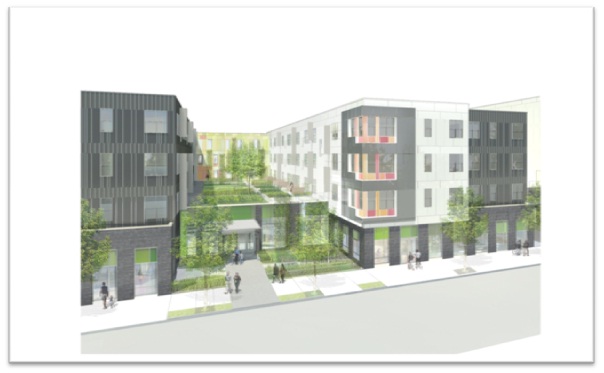
A Green Way to Revitalization
North Philadelphia is an area of contrasts comprised of several neighborhoods and home to a nationally ranked research institution at Temple University. It is also the site of the fourth busiest rail stop in the regional transit system operated by Southeastern Pennsylvania Transit Authority (SEPTA). The area has the lowest levels of educational attainment and the highest concentrations of poverty and abandoned housing in the city. Average household incomes in neighborhoods surrounding Temple range from $20,896 to $ 34,148, well below the city’s median household income. A new transit-oriented development (TOD) project that broke ground in April, Paseo Verde, has the potential to help revitalize this area. Paseo Verde, which translates as “Green Way” in Spanish, is designed to be a sustainable, mixed-use TOD that will offer neighborhood residents and Temple students and employees a place to live, shop, and access community services.
Paseo Verde

Site rendering of Paseo Verde
Image Courtesy of Jonathan Rose Companies
A joint development of Jonathan Rose Companies and Asociacíon Puertorriqueños en Marcha (APM), a local community development organization, Paseo Verde is being built on a 1.9-acre former parking lot located directly adjacent to the Temple University SEPTA Station. Slated for completion in Spring 2013, the 206,000 square foot project will consist of 120 rental units (67 market-rate and 53 affordable units) for low- and moderate-income families that are expected to benefit from greater public transit access. Onsite community services will include a primary care facility operated by Public Health Management Corporation, a pharmacy, and supportive services provided by APM. The building will also include approximately 30,000 square feet of ground floor retail, second floor office space, and community service space.
The green features of Paseo Verde include landscaped terraces, permeable pavement, and a series of green and blue roofs (blue roofs are designed to retain and slowly release rainfall, but unlike green roofs, they are not vegetated). The building design includes an energy-efficient envelope and mechanical systems, photovoltaic solar panels, and the use of local, recyclable, and renewable materials. The development team plans to seek a LEED for Homes and Neighborhood Development certification for the project.
By providing mixed-income housing, the Paseo Verde development will serve both the university community and long-time neighborhood residents. Joanna Cuevas, project manager for Jonathan Rose, notes that the interior design focuses on ensuring flexible living arrangements: “We took care in designing the two bath/two-bedroom units in the market-rate sections to be split-twos, to accommodate roommates such as medical students who might want to split the price to have an affordable place.” Paul Freitag, director of development for the company, notes that Temple has a large number of support staff workers who would also benefit from having quality housing in close proximity to their place of employment.
The combination of affordable and market-rate housing and commercial development for the $47 million project required an array of financing programs through the Philadelphia Redevelopment Authority (PRA), the Federal Home Loan Bank Affordable Housing Program, and other state and local sources. The PRA approved a $4 million loan using HOME funds to finance the affordable units. For the market-rate units, the project relied in part on the New Market Tax Credit (NMTC), a federal program established in 2000 to spur business and real estate projects located in low-income communities. The program permits investors to receive a tax credit against their federal income tax return in exchange for equity investments in organizations that serve low-income communities known as Community Development Entities. Of the NMTC program’s importance, Freitag notes: “I think the NMTC makes a big difference. It makes [the project] viable." Cuevas says that the NMTC “really allowed us to include the 30,000 square feet of retail space where, without it, the project would only have sustained a few thousand square feet. It’s really hard to find capital financing for the development of retail and community service space.”
The Paseo Verde project aims to provide sustainable, affordable housing and much needed community services to residents of neighborhoods around Temple University. The project’s strategic location in close proximity to one of the area’s busiest SEPTA stations ensures that its low-income residents will benefit from lower transportation costs. Cities and regions with existing transit assets can look to Paseo Verde as a useful model for developing mixed-use, mixed income TODs.
PD&R Leadership Message Archive
International & Philanthropic Spotlight Archive
Spotlight on PD&R Data Archive
Publications
Collecting, Analyzing, and Publicizing Data on Housing Turnover
Resilience Planning: What Communities Can Do to Keep Hazards from Turning into Disasters
Cityscape: Volume 26, Number 3
Case Studies
Case Study: Former School in Charleston, South Carolina, Transformed into Affordable Housing for Seniors
Case Study: Avalon Villas Combines Affordable Housing and Services for Families in a Gentrifying Phoenix Neighborhood

The contents of this article are the views of the author(s) and do not necessarily reflect the views or policies of the U.S. Department of Housing and Urban Development or the U.S. Government.
Note: Guidance documents, except when based on statutory or regulatory authority or law, do not have the force and effect of law and are not meant to bind the public in any way. Guidance documents are intended only to provide clarity to the public regarding existing requirements under the law or agency policies.



